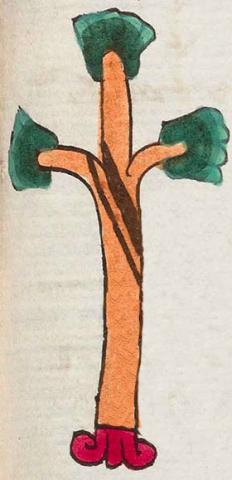cuahuitl (Mdz49r)
This element for tree(s) (cuahuitl) has been carved from the compound sign for the place name, Mictlan Cuauhtlan. This is a tall tree with otherwise classic iconography, a leader and two branches, two-tone green foliage, a terracotta-colored bark, diagonal black lines across the trunk (one thin and one thick), and curling red roots showing above the round.
Stephanie Wood
he black stripes (tlilcuahuitl) are phonetic indicators that this sign is a tree (cuahuitl), something I discovered independently, but which has also been pointed out by Brígida von Mentz ("De árboles, raíces, y locativos en la iconografía del México antiguo," Tlalocan 15, 2008, 216–219).
c. 1541, but by 1553 at the latest
trees, árboles

cuahui(tl), tree(s), https://nahuatl.wired-humanities.org/content/cuahuitl-1
tlilcuahui(tl), black stripe(s), https://nahuatl.wired-humanities.org/content/tlilcuahuitl
Codex Mendoza, folio 49 recto, https://digital.bodleian.ox.ac.uk/objects/2fea788e-2aa2-4f08-b6d9-648c00..., image 108 of 188.
The Bodleian Libraries, University of Oxford, hold the original manuscript, the MS. Arch. Selden. A. 1. This image is published here under the UK Creative Commons, “Attribution-NonCommercial-ShareAlike 3.0 License” (CC-BY-NC-SA 3.0).

